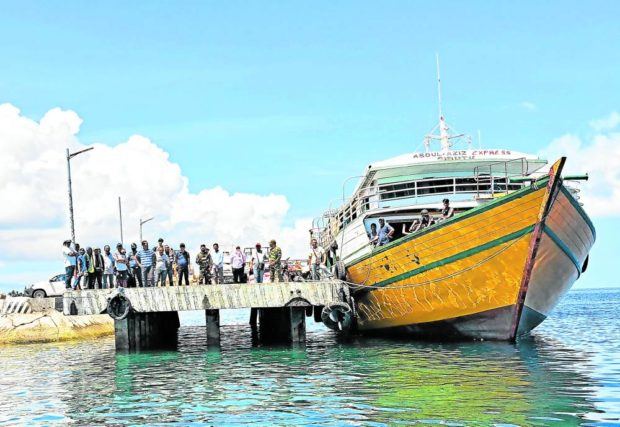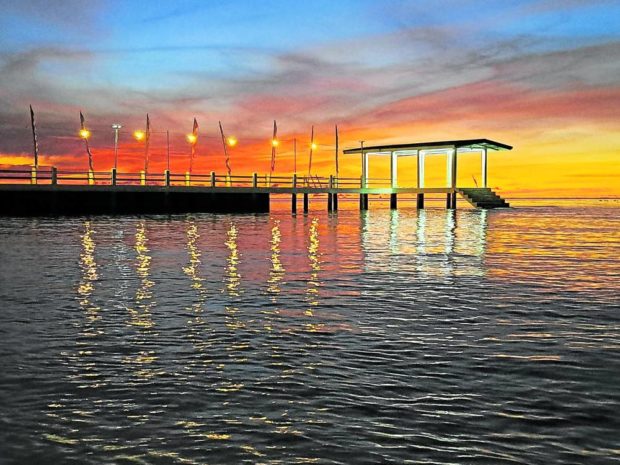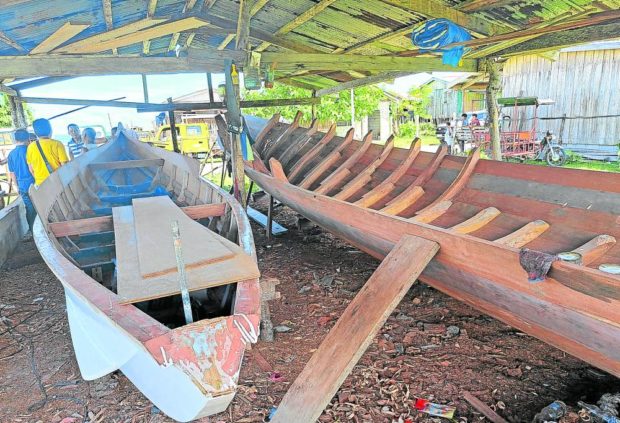Tawi-Tawi’s boat building tradition defies time

LIVING HERITAGE | A “lansa” (wooden-hulled ship) waits for cargo and passengers at the port of Sibutu in Tawi-Tawi province. The town’s centuries-old shipbuilding industry has produced vessels that helped facilitate maritime trade and commerce between the Sulu archipelago and neighboring areas in Southeast Asia. (Photo by BONG S. SARMIENTO / Inquirer Mindanao)
SIBUTU, Tatwi-Tawi, Philippines — With the rough seas as their playground, several villagers in this remote coastal town of Tawi-Tawi province have mastered the art of ark building, a craft that they inherited from their forebears.
Carved out of Sitangkai town in 2006, Sibutu has preserved the age-old craft of building wooden-hulled ships that facilitated the movement of people, goods, and services between the Sulu archipelago and neighboring Malaysia, since time immemorial.
“We have been building wooden-hulled ships with the design drawn in our minds, no blueprint, unlike the engineers of steel-hulled ships,” Ustadz Amin Toroganan told the Inquirer in a recent interview.
The 55-year-old shipwright learned and mastered the skills of wooden boat building from his father, uncles, and cousins, by simply watching them at work when he was young.
As he grew older, he became their helper, which trained him to become one of the skillful wooden boat builders in Sibutu, an island-town some three hours away by “lansa” from Bongao, the provincial capital of Tawi-Tawi.
Article continues after this advertisementA lansa, called “kumpit” when still under construction, is a large wooden-hulled cargo and passenger vessel conspicuously plying the high seas of Tawi-Tawi and neighboring Sulu province ever since.
Article continues after this advertisement
MORNING SPLENDOR | Sunrise paints a splendid scene in Sibutu. Apart from its famed shipbuilding industry, the town also boasts a 9-kilometer continuous stretch of white sand beaches. (Photo by BONG S. SARMIENTO / Inquirer Mindanao)
‘Balangay’ builder
Toroganan’s most unforgettable experience as a wooden boat builder was being part of the team that constructed in 2010 two replicas of Butuan City’s famous “balangay,” which was used by a team headed by former Environment Undersecretary Arturo Valdez in sailing across Southeast Asia then.
Valdez, who led the first successful Philippine expedition to Mt. Everest, launched the “Voyage of the Balangay” in 2009, first building a replica of the balangay in Manila with the masterful hands of Sama-Bajau tribesmen who came all the way from Tawi-Tawi’s Sibutu and Sitangkai towns. It was used for the Philippine leg of the voyage.
At least nine balangay boats, dating as early as 320 A.D., have been discovered in Butuan since the 1970s, with the biggest one, dubbed the “Balangay Mother Boat” due to its size, unearthed in 2012.
The three balangay replicas featured in the voyage sailed across Southeast Asia from 2009 to 2011.
“I am proud that I’m one of those who reconstructed the balangays that retraced the maritime history of yore,” Toroganan said in Filipino.
According to him, he and his group of shipwrights have built at least 80 units of “tempel” or motorized boats with engines of 16 to 32 horsepower (hp), and several lansa in the past few decades.

WORK IN PROGRESS | A pair of “kumpit,” or unfinished “lansa,” is kept under a shed in Bongao, Tawi-Tawi’s capital, while awaiting the hands of master boatbuilders from Sibutu. (Photo by BONG S. SARMIENTO / Inquirer Mindanao)
Sustaining craft
Toroganan is confident that the shipbuilding tradition of Sibutu will not be lost since the younger generation has shown interest to sustain the craft, which helped the town’s shipwrights to feed their families and send their children to school.
“I myself taught my three sons how to build wooden-hulled ships,” he said.
He noted that Sibutu residents inherited the wooden shipbuilding from their ancestors in present-day Malaysia.
Hadji Kuyoh Pajiji, a former Sibutu mayor who owned at least 10 lansa in the past several years, noted that the wooden-hulled cargo and passenger ships are sturdy and can sail across the high seas safely.
He currently operates two wooden vessels — the others already past their good use — to transport dried seaweeds, the main product of Sibutu, to Zamboanga City. On the way back to Sibutu, the vessels carry consumer goods such as soft drinks, rice, canned goods and hardware products, among others.
A fully loaded wooden ship powered by a 350-hp engine can traverse the Sibutu-Zamboanga route in 25 hours, Pajiji said.
Now a septuagenarian, he originally owned a 16-hp outrigger bought by his father, then a government employee, that he used to buy goods from Semporna, Tawau and Sandakan in Malaysia. Pajiji was just in his 20s then. Sibutu is closer to those Malaysian areas than Zamboanga City.
“The kumpit built by the shipwrights of Sibutu are reliable. For ages, these are the ones that have been plying from the ports of Bongao toward the other island-towns in Tawi-Tawi and Sulu, and with neighboring Malaysia,” he told the Inquirer.
Sibutu, which boasts of a 9-kilometer stretch of white sand beaches, has 16 villages, and wooden boat builders can be found in each one of them, Pajiji said.
Trade, tourism
Owing to their mastery of the craft, they can finish a kumpit in six months, he added.
Pajiji said that many small-scale tuna producers in General Santos City, dubbed the “Tuna Capital of the Philippines,” and its neighboring areas, have sought Sibutu’s shipwrights to build their fishing boats.
“Our shipbuilding industry continues to thrive because the craft is passed on from generation to generation,” he noted.
Mayor Nur-Fitra Ahaja says Sibutu is proud to showcase the boat building industry to tourists visiting and exploring the locality, which hosts the shrine of Sheik Makdum who was the first Arabian missionary to propagate Islam in Mindanao in 1380 and was believed to have been buried here.
Aside from the shipbuilding industry, Sibutu also takes pride in its seaweed industry and long stretches of powdery white sand beaches, including in its island villages.
Tawi-Tawi is part of the Bangsamoro Autonomous Region in Muslim Mindanao (BARMM), which is seated in Cotabato City. There are daily flights from Zamboanga to Bongao, the provincial capital, and twice weekly from Cotabato to Bongao, the latter served only starting in June.
BARMM spokesperson Naguib Sinarimbo said the Cotabato-Bongao route will accelerate the exchange of people, goods and services between Cotabato and the landlocked provinces of Maguindanao and Lanao del Sur with the island-provinces of Tawi-Tawi and Sulu.
“Tourists from the Bangsamoro mainland can directly fly and enjoy what Tawi-Tawi can offer,” he said. “Fine white sand beaches, exotic seafood, rich cultural heritage and friendly people await the curious tourists.”
Ahaja says one of the tourism attractions of the town is Sicolan Island, home to the Saluag Lighthouse Station, which is proof of the age-old maritime route’s importance to the locality and which can explain why the shipbuilding industry has been thriving here for centuries. Sicolan Island is 30 minutes away by boat from Sibutu mainland.
The town’s other jewel is the Sibutu Strait or Passage, a deep channel about 29 km wide that connects the Sulu and Sulawesi seas. The strait is used by cargo vessels for international trade between the Pacific and Indian Oceans. Some 15,000 ships reportedly use the Sibutu Straight for passage annually.
According to Ahaja, the town has been lighting the way for international and domestic cargo vessels with the Saluag lighthouse, a silent witness to the growth of the local shipbuilding industry.
RELATED STORIES
Keeping ‘balangay’ legacy alive
‘Sailing is in our DNA’: Balangay back from voyage to China
Bill naming ‘balangay‘ as national boat returned to Senate committee level